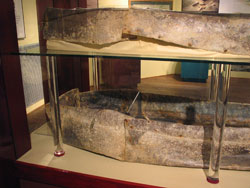To Display or Not to Display
The exhibition of any artifact has inherent risks. Damage can be caused by light, vibrations, and fluctuation in heat and humidity. Care must be taken to design exhibitions which inform the public, without destroying the evidence of the past. A balanced approach which appreciates both needs and desires must be established.
The largest lead coffin is on exhibition at HSMC as an educational tool for the public.
Over time this artifact has begun to show signs of object stress due to sheer weight, the softness of lead, and the corroded condition.

A special armature was built to support the largest of the lead coffins on display at St. Mary’s City. The coffin was made with a top and bottom which fitted together like a shoe box.
Custom designed museum mounts brace the object but constant monitoring is needed. Lead is also sensitive to organic acids and high pH.
The case that houses the coffin had to be constructed out of inert, museum-quality materials, like glass, that do not off-gas or degrade. This dramatically decreases the rate of deterioration among archaeological collections. Many of the organic materials recovered from the coffins are very sensitive to fluctuations in relative humidity and exposure to ultraviolet radiations. The objects receive minimal handling and their cases are monitored for environmental changes with the aid of a hygrothermograph. Light is kept low, to avoid damage to pigments, and objects are regularly inspected for mold and signs of pest infestation. The exhibition of these artifacts is limited to three months.


